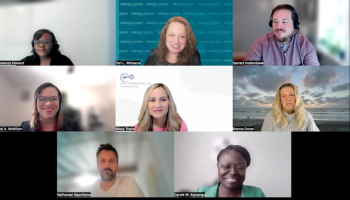
Scientists Tackle Viral Mysteries
Scientists know that some cancers are triggered by viruses, which take over cellular systems and cause uncontrolled cell growth. Doctors – and patients who get shingles late in life – have also known for many years that some viruses, particularly the herpes virus, can lie dormant in a person’s cells for long periods of time and then reactivate, causing disease. These viruses also cause significant disease in immunosuppressed people and those living with HIV/AIDS.
A recent study led by Blossom Damania, PhD, associate professor of microbiology and immunology at the University of North Carolina at Chapel Hill, focuses on the intersection of these two scientific puzzles, resulting in new discoveries about how one herpesvirus known to cause cancer may reactivate when the infected cell senses another type of virus entering it.
Damania, who is also a member of the UNCLinebergerComprehensiveCancerCenter, focused on Kaposi’s sarcoma-associated herpesvirus (KSHV), an agent associated with Kaposi’s sarcoma, primary effusion lymphoma and another syndrome called Castleman’s disease.
“We hypothesized that a secondary viral infection could serve as the trigger for KSHV, so we took cells infected with KSHV and activated immune receptor proteins called toll-like receptors that are present on the body’s cells. Toll-like receptors are the guardians of the cell and essentially function to alert the cell to the presence of an intruder. These proteins act as an alarm system to tell the cell that a foreign organism is trying to enter it,” said Damania.
Ten human toll-like receptors have been identified by scientists thus far, but the UNC team found that activation of only two of them, TLR7 and TLR8, reactivated the virus, allowing it to reproduce itself. The cells self-destruct in an attempt to kill the virus, but by the time the cell dies, the virus has already replicated and escaped, moving on to infect other cells in the body.
“This is a very exciting finding because it helps us better understand how a latent virus can suddenly reactivate, replicating and spreading throughout the body. Additionally, since Kaposi’s sarcoma is a cancer that is associated with this phase of viral infection, it is plausible that the virus’ activation and replication may eventually lead to the development of Kaposi’s sarcoma in an infected individual.
“Laboratory experiments in a controlled research environment often do not reflect the real world, where we are constantly exposed to many different environmental factors and other microorganisms. This finding is an important reminder that multiple factors are involved in causing disease,” she added.
The research was published today in the Proceedings of the National Academy of Sciences. Study co-authors from the UNC Lineberger Comprehensive Cancer Center include first-author Sean Gregory, graduate student; John West, PhD postdoctoral fellow; Patrick Dillon, PhD postdoctoral fellow; and Dirk Dittmer, PhD, associate professor of microbiology and immunology.
This work was supported by the National Institutes of Health, the Leukemia and Lymphoma Society and the Burroughs Wellcome Fund. Damania is a Leukemia and Lymphoma Society Scholar and a Burroughs Wellcome Fund Investigator in Infectious Disease.
Newsletter
Stay prepared and protected with Infection Control Today's newsletter, delivering essential updates, best practices, and expert insights for infection preventionists.





